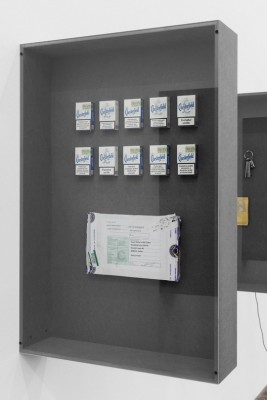The “Random Darknet Shopper” is a bot that buys a random item from the Agora marketplace once a week, and has the item mailed to the !Mediengruppe Bitnik art collective, who display the item in a gallery space. The bot is given an allowance of $100 a week to make its purchases.
I was initially drawn to this project by this article on Motherboard, which details just the “best things” that the bot purchased. There’s something comical about the way it’s covered by Motherboard; the bot is heavily anthropomorphized and given a personality by way of the products it purchases and a hypothesized reason or backstory for the purchases. It doesn’t seem like this was intentional on the part of the authors, but raises an interesting set of questions regarding agency and legality. Specifically, at what point would a robot be considered to have agency on its own? At what point would an illegal action, such as purchasing drugs, be attributable to the robot and not to the creator?
The authors do not say much about their intention, but they seem focused on giving tangibility to the dark web and describing its idiosyncrasies. Several of their descriptions for the products focus on the quality of product or service, such as “Shipment took 2 weeks,” and “Ordered from the U.S. – arrived from Singapore.” These descriptions remind us that real people and systems are on the other end of the transaction.
The “Random Darknet Shopper” is influenced by the Random Shopper by Darius Kazemi, which makes random purchases on Amazon. Darius’ intentions were to break out of algorithmic profiling. Both bots seem are conceptually similar to other bots, such as twitter bots, but with a very specific method of agency.
2015 Interaction Awards: Flutter from Interaction Design Association on Vimeo.
Flutter – by Alex Rothera, Ivor Williams, Jacopo Atzori, and Aaron Gillett
Flutter is a mobile application designed for grieving adolescents to help them express themselves and give form to their feelings. The user taps on the screen to define base notes and then can place objects above or around the note to modulate it. This project is particularly interesting to me for two reasons: the goal of empowering creativity and the design process. When I think of interactive art, one of the main things that comes to mind is designing interaction from the user’s perspective and allowing them to explore and create on their own. Regarding the design process, it’s just great to hear them talk about how they used contextual design and see the process I’m learning at CMU in action.
I thought the parts that worked especially well were the end, “captured” musical result and the simplicity of interaction and control. However, the abstraction of musical control seems a bit simplistic, almost like bad Instagram filters. Maybe the abstractions just grate against my mental model of electronic music and would work well for the intended audience.
They don’t say what their specific influences are, but there are many generative music applications. In particular, Flutter reminds me of the Brian Eno application Bloom, as both have a down-tempo, subdued musicality.
